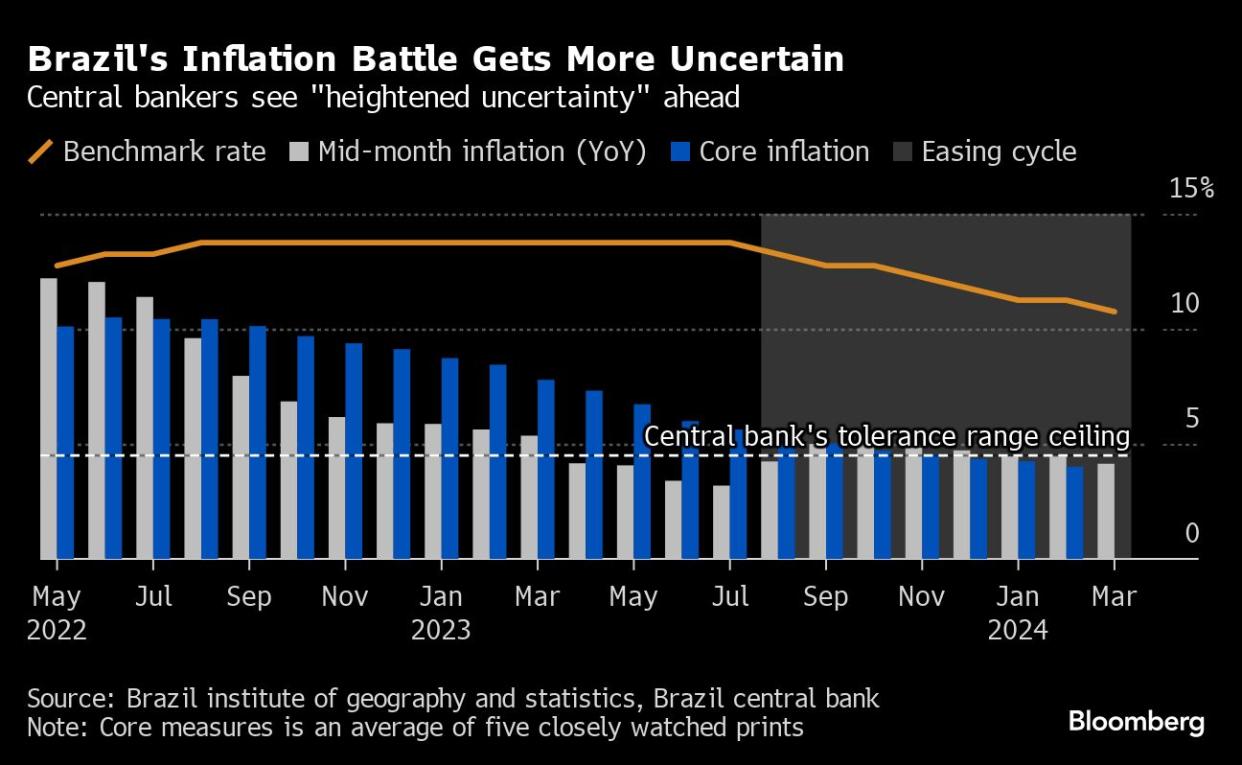Brazil’s Central Bank Discussed Smaller Interest Rate Cuts Ahead Due to Uncertainties

(Bloomberg) -- Brazil’s central bank discussed the possibility of smaller interest rate cuts ahead, citing increased uncertainties and the need for more monetary policy flexibility in Latin America’s largest economy.
Most Read from Bloomberg
Trump’s Net Worth Hits $6.5 Billion, Making Him One of World’s 500 Richest People
Biden Gains Ground Against Trump in Six Key States, Poll Shows
Japan Amps Up Intervention Threat as Yen Hits Lowest Since 1990
Trump Vows to Pay Fraud Trial Bond Cut by 68% to $175 Million
Using Your Premium Credit Card May Cost More After Visa-Mastercard Deal
Some board members argued that a slower pace of monetary easing “may prove appropriate,” in the future, according to the minutes to the March 19-20 rate-setting meeting, when policymakers lowered the benchmark Selic to 10.75%. Central bankers led by Roberto Campos Neto have so far cut borrowing costs by 50 basis points at each decision in their cycle.
“The baseline scenario had not changed substantially but given its uncertainties, it was deemed appropriate to have greater monetary policy flexibility,” central bankers wrote in the minutes published on Tuesday.
Until now, central bankers had reinforced they had enough visibility to keep the same easing pace for at least two meetings ahead. Last week, they changed their guidance to indicate another half-point cut at the next decision, in May.
Still, the board “emphasized that it would be a mistake to interpret the change in the future signaling as an indication of a change in the monetary policy cycle compatible with the baseline scenario.”
Brazil’s central bank is reviewing its strategy after having reduced borrowing costs by three percentage points so far since August. The costs of services and staple foods like rice and beans are picking up, clouding the inflation outlook, especially for the poor. Consumer price estimates have persistently remained above the 3% target through 2026 as policymakers warn of high uncertainty.
What Bloomberg Economics Says:
The Brazilian central bank’s meeting minutes look carefully crafted to debunk two interpretations of policymakers’ decision to shorten their forward guidance last week. It hinted that another 50-basis-point rate cut in June is still possible, and said a slower pace of easing wouldn’t necessarily mean the cycle is nearly over. The minutes, which included some other hawkish messages, back our long-held call for slower rate cuts from midyear and a year-end policy rate of 9%.
— Adriana Dupita, Brazil and Argentina economist
— Click here for full report
Swap rates on the contracts due in January 2025, which indicate market sentiment about monetary policy at the end of this year, rose four basis points on Tuesday morning, with traders seeing greater odds of a double-digit Selic in December.
Inflation Report
A separate release published on Tuesday showed annual inflation slowed less than expected in early March, to 4.14%. Consumer prices rose 0.36% on the month, the national statistics agency reported.
Food and beverages were the top inflation driver, rising 0.91% on the month. Health costs rose 0.61% during the period.
Policymakers are also concerned about more expensive services driven by a tight labor market, given that they could indicate a more gradual inflation slowdown ahead. Central bankers still see the need for restrictive rates as unemployment remains low while the economy records strong formal job creation and real wage gains.
“The Committee noted that a slower disinflationary process, both domestically and globally, does not constitute the baseline scenario but has been incorporated as a source of uncertainty,” they wrote in the minutes. Central bankers will continue to monitor the degree of slack in the labor market.
Raising Doubts
The adjustment in central bank guidance comes as Brazil President Luiz Inacio Lula da Silva pushes for ways to quickly improve living standards amid pressure from a slowing economy and a decline in popularity.
Investors are growing anxious over signs that Lula wants state-controlled companies to help bolster economic growth. Finance Minister Fernando Haddad’s plans to shore up public accounts are also at risk, as a better-than-expected tax collection provides an argument to raise public spending.
Amid an unclear budget outlook, central bankers have reinforced the need to “firmly persist” in Haddad’s plans to eliminate this year the primary fiscal deficit, which excludes interest payments.
Most analysts see borrowing costs at 9% by December and 8.5% at the end of 2025, according to a central bank survey also published on Tuesday.
“The Copom is raising doubts about the speed of disinflation,” JPMorgan Chase & Co. analysts Cassiana Fernandez and Vinicius Moreira wrote in a research note. “We see this shift as raising the risk of a deceleration in the pace of easing to 25bp cut in June.”
--With assistance from Giovanna Serafim.
(Updates with more details from reports, market reaction and economist comments throughout)
Most Read from Bloomberg Businessweek
Hong Kong’s Elderly Are Increasingly Retiring in Mainland China
In This Coworking Space, Only the Cappuccino Isn’t Classified
©2024 Bloomberg L.P.


